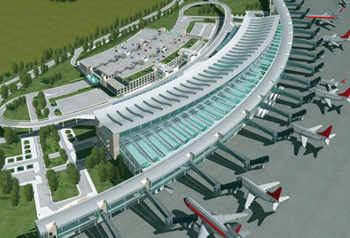Largest airport takes off in Istanbul
01 July 2014
CONSTRUCTION work was launched on Istanbul’s third and the world’s biggest airport, with a ground-breaking ceremony last month (June 7).
Turkish Prime Minister Recep Tayyip Erdogan laid the foundation stone for the multi-billion-dollar project, which will be built in Arnavutkoy, a district in the northern part of Istanbul, on the European side.
It is expected to be used annually by an estimated 150 million passengers, thus becoming one of the world’s busiest air hubs.
The airport project, comprising four stages, will cost €10.247 billion ($14 billion).
With its 90-million-passenger capacity in its first phase, parking zone broad enough for 500 planes and 76-million-sq-m area, the airport is targeted to be the largest in the world and the biggest transfer hub in Europe.
Erdogan said the first phase of the airport would be launched on October 29 of 2017, marking Turkey’s 94th Republic Day.
Istanbul’s two airports, currently operational, were visited by a total of over 70 million passengers in 2013, revealing capacity issues as the number continued to rise.
Transportation Minister Lutfi Elvan said Turkey’s passenger numbers has increased by 11 million last year.
In 20 years’ time, Istanbul airports’ commercial aircraft traffic will exceed one million aircraft carrying 118 million passengers per year, according to a 2010 forecast by Turkey’s Middle East Technical University.
The new airport will have 165 passenger boarding bridges, four terminals connected with a railway system, three maintenance buildings, eight air traffic control towers, six runways, 16 taxiways, an airport apron of 6.5 million sq m with a capacity of 500 airplanes, a car park with a capacity of about 70,000 vehicles and touted as the largest airport car-park in Europe, a clinic, fire department, hotels, a convention centre, and recycling and waste disposal plants. It will be connected to the Istanbul metro, and multi-lane highways will be built to facilitate access to the airport.
A Turkish consortium comprising Cengiz, Kolin, Limak, Mapa and Kalyon had won a tender for the third Istanbul airport in May 2013, promising to pay the state €22.1 billion, plus taxes, to run the airport over a 25-year period starting in 2017.
About 350,000 tonnes of iron and steel components, 10,000 tonnes of aluminium component and 415,000 sq m of glass will be used in the construction. It will also act as a focal point for the Turkish Airlines, Turkey’s flag carrier, which is one of the fastest growing airline companies, flying currently to 208 international destinations.
The airport is expected to link Asia to North America and Africa to Europe and become a key international transit point and a viable alternative to Frankfurt airport in Germany.



